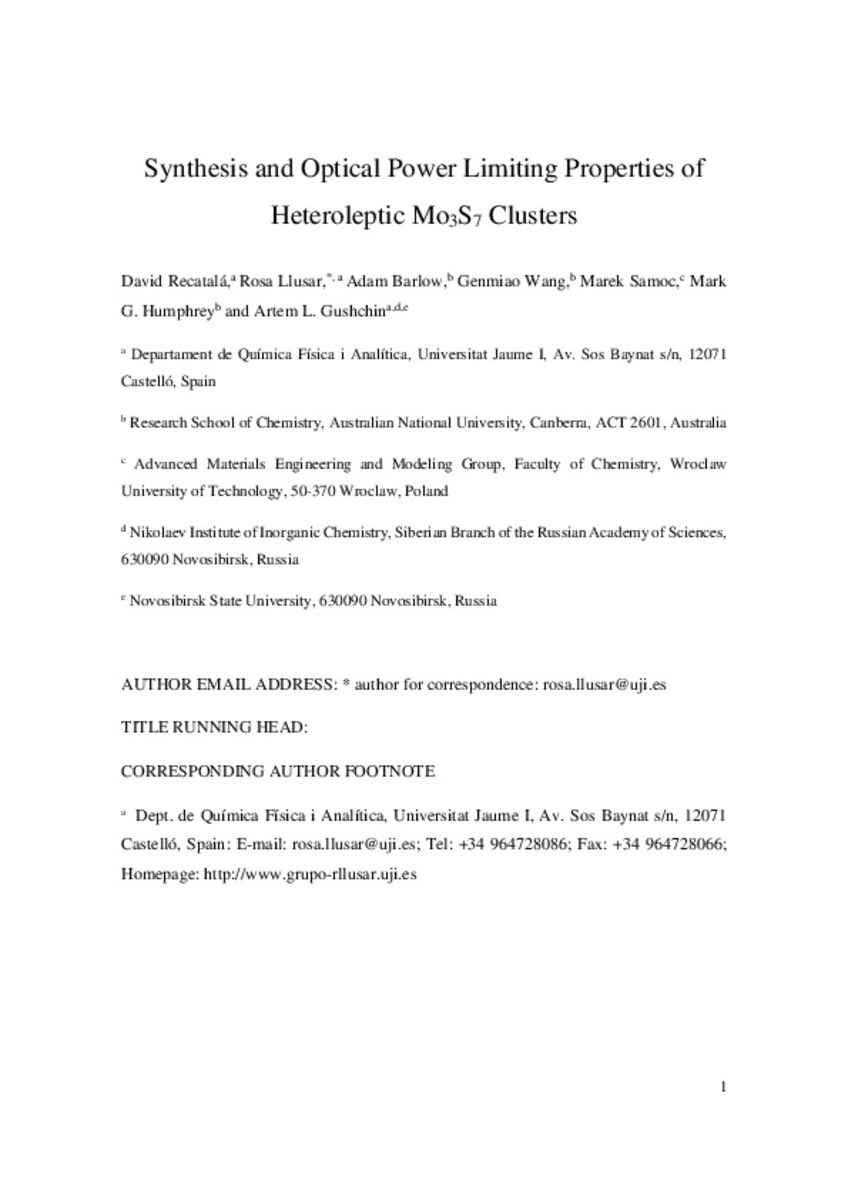Mostra el registre parcial de l'element
Synthesis and optical power limiting properties of heteroleptic Mo3S7 clusters
| dc.contributor.author | Recatalá Ferrandis, David | |
| dc.contributor.author | Llusar, Rosa | |
| dc.contributor.author | Barlow, Adam | |
| dc.contributor.author | Wang, Genmiao | |
| dc.contributor.author | Samoc, Marek | |
| dc.contributor.author | Humphrey, Mark G. | |
| dc.contributor.author | Gushchin, Artem L. | |
| dc.date.accessioned | 2016-06-08T14:55:25Z | |
| dc.date.available | 2016-06-08T14:55:25Z | |
| dc.date.issued | 2015 | |
| dc.identifier.issn | 1477-9226 | |
| dc.identifier.issn | 1477-9234 | |
| dc.identifier.uri | http://hdl.handle.net/10234/160476 | |
| dc.description.abstract | Substitution of the halide ligands in (Bu4N)2[Mo3S7X6] (X = Cl, Br) by diimine ligands, such as 4,4′-dimethyl-2,2′-bipyridine (dmbpy), 2,2′-bipyridine (bpy) and 1,10-phenanthroline (phen), affords the neutral heteroleptic clusters Mo3S7Cl4(dmbpy) (1), Mo3S7Br4(dmbpy) (2), Mo3S7Br4(bpy) (3), and Mo3S7Br4(phen) (4). Further substitution of the halide ligands in Mo3S7Br4(diimine) clusters by dmit (1,3-dithiole-2-thione-4,5-dithiolate) allows the preparation of the mixed diimine–dithiolene neutral cluster complexes Mo3S7(dnbpy)(dmit)2 (5, dnbpy = 4,4′-dinonyl-2,2′-bipyridine), Mo3S7(dcmbpy)(dmit)2 (6, dcmbpy = 4,4′-dimethoxycarbonyl-2,2′-bipyridine), and Mo3S7(dcbpy)(dmit)2 (7, dcbpy = 2,2′-bipyridine-4,4′-dicarboxylic acid). The optical limiting properties of complexes 1–7 have been assessed by the open-aperture Z-scan technique at 570 nm, employing a nanosecond optical parametric oscillator. In order to investigate the effect of increasing the π-system, complexes 1–4, with the general formula Mo3S7X4(diimine), (X = Cl, Br), were compared to clusters 5–7, containing the dmit ligand. The influence of the metal content on the optical power limiting properties was also investigated by comparing the trinuclear series of complexes prepared herein with the bis(dithiolene) dinuclear cluster (Et4N)2[Mo2O2S2(BPyDTS2)2], which has been recently prepared by our group. All trinuclear clusters 1–7 are efficient optical limiters (σeff > σ0) with the threshold limiting fluence F15% decreasing on proceeding from dinuclear to trinuclear clusters and, generally, on extending the π-system. | ca_CA |
| dc.description.sponsorShip | Financial support from the Spanish Ministerio de Economia y Competitividad (MINECO) (Grant CTQ2011-23157), UJI (research project P1.1B2013-19) and Generalitat Valenciana (Prometeo/2014/022 and ACOMP/2014/274) is gratefully acknowledged. The authors also thank Serveis Centrals d ’ Instrumentació Cientifica (SCIC), within Universitat Jaume, I for providing them with materials characterization facilities. D. R. thanks the Spanish Ministerio de Economía y Competividad for a predoctoral fellowship. M. G. H. thanks the Australian Research Council for support. M. S. acknowl- edges the NCN grant DEC-2013/10/A/ST4/00114 | ca_CA |
| dc.format.extent | 10 p. | ca_CA |
| dc.format.mimetype | application/pdf | ca_CA |
| dc.language.iso | eng | ca_CA |
| dc.publisher | Royal Society of Chemistry | ca_CA |
| dc.relation.isPartOf | Dalton Transactions, 2015, vol. 44, núm. 9 | ca_CA |
| dc.rights | This journal is © The Royal Society of Chemistry 2015 RECATALÁ, David, et al. Synthesis and optical power limiting properties of heteroleptic Mo 3 S 7 clusters. Dalton Transactions, 2015, vol. 44, no 29, p. 13163-13172. <http://dx.doi.org/10.1039/c5dt01244a> -- Reproduced by permission of The Royal Society of Chemistry | ca_CA |
| dc.rights.uri | http://rightsstatements.org/vocab/InC/1.0/ | * |
| dc.subject | Chlorine compounds | ca_CA |
| dc.subject | Ligands | ca_CA |
| dc.subject | Molybdenum | ca_CA |
| dc.subject | Optical parametric oscillators | ca_CA |
| dc.subject | Optical properties | ca_CA |
| dc.title | Synthesis and optical power limiting properties of heteroleptic Mo3S7 clusters | ca_CA |
| dc.type | info:eu-repo/semantics/article | ca_CA |
| dc.identifier.doi | http://dx.doi.org/10.1039/C5DT01244A | |
| dc.rights.accessRights | info:eu-repo/semantics/openAccess | ca_CA |
| dc.relation.publisherVersion | http://pubs.rsc.org/en/Content/ArticleLanding/2015/DT/c5dt01244a#!divAbstract | ca_CA |
| dc.type.version | info:eu-repo/semantics/submittedVersion | ca_CA |
Fitxers en aquest element
Aquest element apareix en la col·lecció o col·leccions següent(s)
-
QFA_Articles [817]
Articles de publicacions periòdiques







